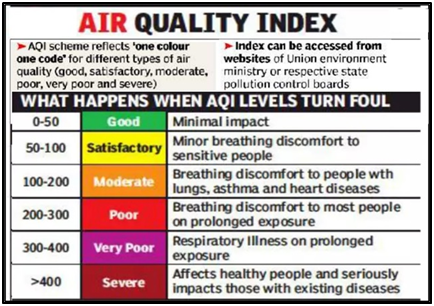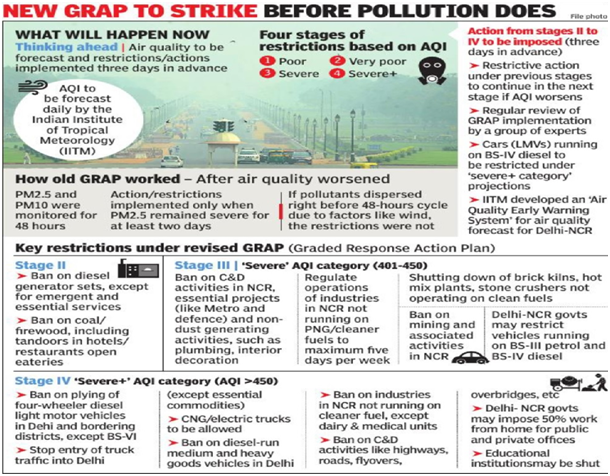Why in news?
- The air quality in Delhi turned ‘severe’ as its average AQI was 447 on January 14.
- The sudden deterioration in air quality prompted the Commission for Air Quality Management (CAQM) to invoke stage 3 measures under the Graded Response Action Plan (GRAP) across Delhi-NCR with immediate effect.
What’s in today’s article?
- Air Quality Index (AQI)
- Commission for Air Quality Management (CAQM)
- Graded Response Action Plan (GRAP)
- News Summary
Air Quality Index (AQI)
- AQI was launched in October 2014 to disseminate information on air quality in an easily understandable form for the general public.
- The measurement of air quality is based on eight pollutants, namely, PM10, PM2.5, NO2, SO2, CO, O3, NH3, and Pb
- The AQI transforms complex air quality data of various pollutants into a single number for ease of understanding.

Commission for Air Quality Management (CAQM)?
- CAQM is a statutory body formed under the Commission for Air Quality Management in National Capital Region and Adjoining Areas, Act 2021.
- The commission aims at better coordination, research, identification, and resolution of problems related to air quality in NCR and adjoining areas.
Graded Response Action Plan
- About
- GRAP is a set of emergency measures that kick in to prevent further deterioration of air quality once it reaches a certain threshold in the Delhi-NCR region.
- It was approved by the Supreme Court in 2016 and notified in 2017.
- The plan was formulated after several meetings between Environment Pollution (Prevention and Control) Authority (EPCA), state government and experts.
- GRAP works only as an emergency measure.
- The plan does not include action by various state governments to be taken throughout the year to tackle industrial, vehicular and combustion emissions.
- Nature

- GRAP is incremental in nature and thus, when the air quality dips from ‘poor’ to ‘very poor,’ measures listed under both sections have to be followed.
- Stage 1 of GRAP is activated when the AQI is in the ‘poor’ category (201 to 300);
- Stage 2 is when it’s in the ‘Very poor’ category (301-400);
- Stage 3 is when the AQI is the ‘Severe’ category (401-450); and
- Stage 4 is when it rises to the ‘Severe +’ category (more than 450).
News Summary: Delhi AQI severe
- Delhi’s 24-hour average air quality index (AQI) was recorded at 447 (severe) on January 14. As a result, CAQM invoked stage 3 measures under the GRAP across Delhi-NCR.
- The sudden to a spike in pollution levels was due to the combination of:
- low wind speed,
- frigid temperatures,
- rise in the moisture levels,
- low mixing heights and
- impact of biomass combustion across the city
- Invoked for the third time this winter season, the eight measures include a ban on BS- III petrol and BS-IV diesel four-wheelers plying across Delhi-NCR region.
- The measures also effectively ban private construction in the region.











